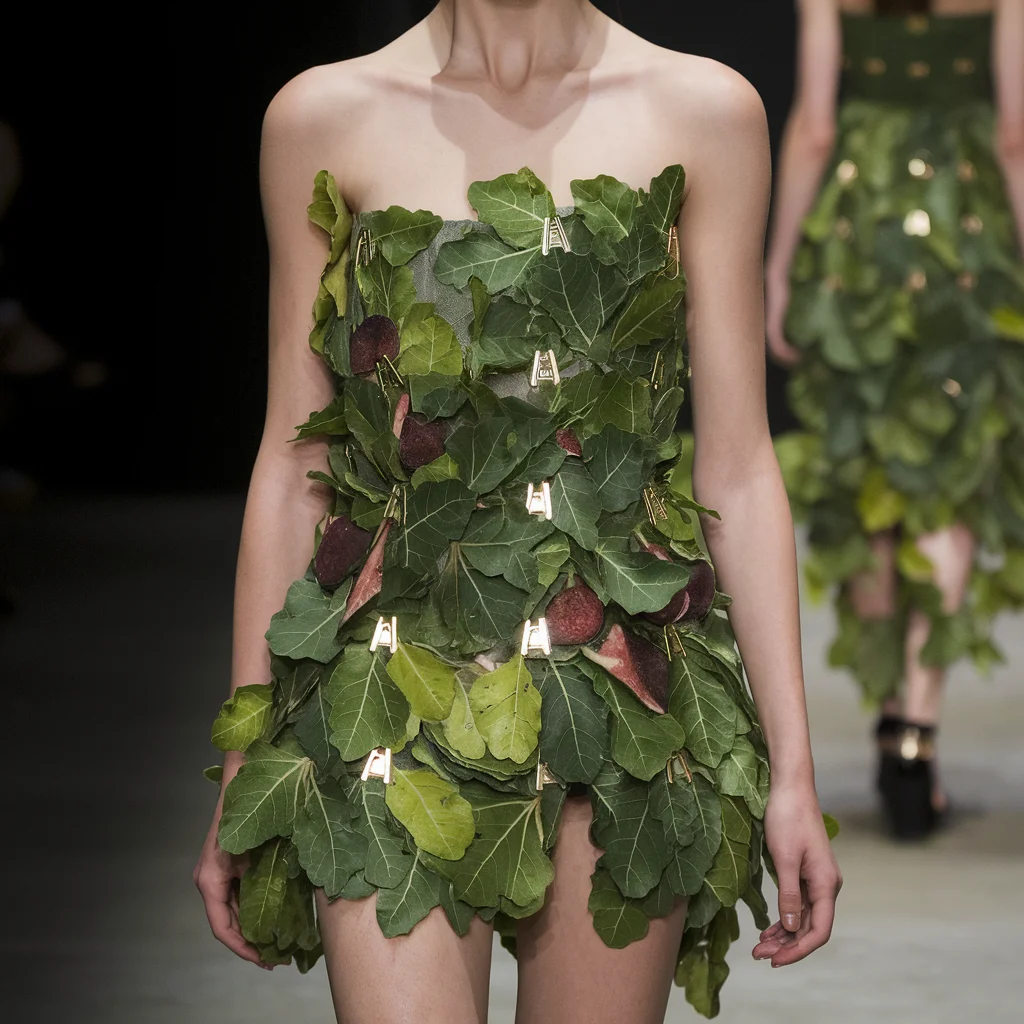Fashion has long drawn inspiration from nature, and one of the most interesting and unexpected symbols to emerge is the fig leaf. Initially tied to modesty and religious iconography, the fig leaf has evolved significantly over the centuries, becoming a statement of freedom, rebellion, and environmental consciousness. This transformation illustrates how fashion can subvert meaning, turning symbols of the past into powerful expressions of contemporary identity. To understand where fig leaves came into fashion, it’s essential to explore their historical and cultural journey, tracing their roots from ancient symbolism to their reimagining in modern style.

If you want to know more about Fashion Icon then checkout our last blog post.
The Ancient Roots. The Fig Leaf First Symbolism
The fig leaf’s connection to fashion begins in the distant past, especially in religious and cultural contexts. The earliest and perhaps most influential reference comes from the Bible. According to the Book of Genesis, after Adam and Eve realized their nakedness, they used fig leaves to cover their bodies. This act, initially one of modesty and shame, placed the fig leaf at the heart of Western cultural understandings of nudity and morality. As a result, for centuries, the fig leaf became synonymous with concealment, modesty, and even guilt.
In Ancient Greece and Rome, the fig leaf maintained its role as a modest cover for the human body. The ancient world often depicted nude bodies, especially in art, as symbols of idealized beauty, but nudity had to be censored. As such, artists of the Renaissance period frequently used fig leaves to cover the genitalia of sculptures and paintings. This marked the fig leaf’s role as a boundary between art and moral standards. Its use as a covering device, even in the context of celebrated art, signified an attempt to reconcile nature with societal norms.
The Renaissance and Beyond. The Fig Leaf in Art
During the Renaissance, artists began to explore human anatomy in greater detail, pushing the boundaries of religious and cultural norms. Yet, even as they celebrated the beauty of the human form, they faced pressure to abide by Christian views on modesty. The fig leaf became a solution to this paradox. The most famous example lies in Michelangelo’s “David,” a statue of perfect human form. The original statue had no fig leaf, but many of its copies and reproductions featured a strategically placed fig leaf to cover its genitalia. The leaf thus became a symbol of both artistic freedom and the social constraints of the time.
Even after the Renaissance, the fig leaf continued to appear in works of art, frequently used as a modest cover for naked bodies. Whether in paintings, sculptures, or religious iconography, artists relied on the fig leaf to suggest modesty, even when the body itself was depicted as beautiful and natural. This duality between nudity and modesty persisted for centuries, keeping the fig leaf firmly within the cultural lexicon.
Shifting Symbolism. The Fig Leaf and Environmental Consciousness
Fast forward to the mid 20th century, and the fig leaf symbolism began to shift dramatically. With the rise of environmentalism in the 1960s and 1970s, nature became a focal point of cultural and political movements. At this time, the fig leaf, already deeply connected to the natural world, found new meaning. As concerns about environmental degradation grew, so did the desire for a return to nature, and the fig leaf became an emblem for sustainability.
Designers and activists in the 1960s embraced eco consciousness, promoting natural fibers, organic materials, and a closer relationship with the earth. The fig leaf, with its unmistakable ties to nature, became a symbol of this movement. Brands promoting eco friendly products began to use the fig leaf in their logos and advertising, helping to cement its place as a symbol of both environmentalism and simplicity. This shift reflected the era’s growing awareness of the need to protect the planet and live in harmony with nature.
This connection between the fig leaf and environmentalism grew stronger over time. In the 1990s, fashion houses like Stella McCartney, known for their commitment to sustainable fashion, began incorporating natural motifs like the fig leaf into their designs. It wasn’t just a passing trend, it was a deliberate effort to align the fashion world with more ethical and sustainable practices. As the fashion industry became increasingly concerned with the environmental impact of its practices, the fig leaf emerged as a natural symbol of the movement, combining beauty, nature, and ethics in a single image.

If you want to know more about Fashion Icon then checkout our last blog post.
The Rebellious Revival. Fig Leaves in Feminist and Counter Culture Movements
The 1960s also marked a period of profound cultural upheaval. As feminist and counter culture movements gained momentum, traditional ideas about gender, sexuality, and modesty began to be challenged. The fig leaf, once a symbol of modesty, was reimagined as a tool for subversion. Instead of representing shame, it became a playful and ironic cover for the body one that was no longer bound by old fashioned restrictions.
During the sexual revolution, people sought to reclaim their bodies and sexual identities. The fig leaf, which had once been used to cover shame, was now used to reclaim freedom and expression. It appeared in fashion advertisements, photo shoots, and artwork as a means of playing with societal norms. Instead of suppressing sexuality, the fig leaf now played with the boundaries between concealment and revelation. The leaf became a cheeky and symbolic way of saying, “I control how much I reveal.”
Designers like Jean Paul Gaultier embraced this new approach, incorporating the fig leaf into their work. Gaultier, known for his avantgarde and often gender defying fashion, used fig leaf designs to question traditional gender roles and sexual norms. In doing so, he and other designers helped turn the fig leaf into an emblem of rebellion, a symbol of both artistic freedom and social resistance. The fig leaf, previously a cover up, now became a tool of empowerment and liberation.
The Fig Leaf in Contemporary Fashion. Symbolizing Freedom and Sustainability
In the 21st century, the fig leaf continues to make appearances in fashion, but its meaning has become even more layered. Today, it represents not only a playful commentary on modesty and sexuality but also a commitment to environmental sustainability. As young people around the world embrace eco friendly lifestyles and demand more ethical practices from the fashion industry, the fig leaf has once again found its place in modern wardrobes.
One of the most striking examples of the fig leaf’s contemporary relevance can be seen in sustainable fashion brands. Designers who prioritize environmentalism often incorporate fig leaves into their collections, using them as a symbol of the connection between style and nature. By choosing natural fibers, dyes, and eco conscious production methods, these brands have made the fig leaf a prominent symbol of both fashion and environmental responsibility. The fig leaf, once a symbol of shame and modesty, now reflects a commitment to preserving the planet for future generations.
Streetwear has also embraced the fig leaf as a bold and stylish motif. Designers create graphic tees, hoodies, and accessories featuring fig leaf prints, often with a cheeky or ironic twist. This modern interpretation of the fig leaf is a way for individuals to express their connection to nature while maintaining a sense of playful rebellion. In this context, the fig leaf no longer signifies repression or concealment but instead serves as a statement of individuality and environmental awareness.
The Fig Leaf’s Symbolic Evolution in Fashion
Fashion, at its core, reflects the cultural shifts and values of society. The fig leaf’s evolution from a symbol of modesty and shame to one of environmental activism and personal freedom mirrors the changing attitudes toward the body, nature, and individual expression. The fig leaf has transformed from a tool of concealment to an emblem of empowerment, rebellion, and sustainability.
Today, the fig leaf is everywhere, from haute couture collections to street fashion, used not only as a symbol of environmentalism but also as a way to challenge traditional ideas of modesty and gender. Designers and fashion lovers alike have reclaimed the fig leaf, turning it into a powerful statement about freedom, self expression, and the need for a more sustainable future.

If you want to know more about Fashion Icon then checkout our last blog post.
Conclusion
The fig leaf come in to fashion journey through history, art, and fashion demonstrates how a symbol can evolve to reflect changing cultural attitudes. What began as a symbol of modesty in the Bible and ancient art became a symbol of freedom and rebellion in the 20th century, and today it serves as a powerful emblem of sustainability and individual expression. The fig leaf’s journey from a tool of concealment to a symbol of empowerment shows how fashion can challenge norms, subvert expectations, and embrace new meanings. As the fashion industry continues to evolve, the fig leaf remains an enduring symbol of the intersection of nature, culture, and style.



Pingback: 1920s Fashion Men: A Decade of Style and Change